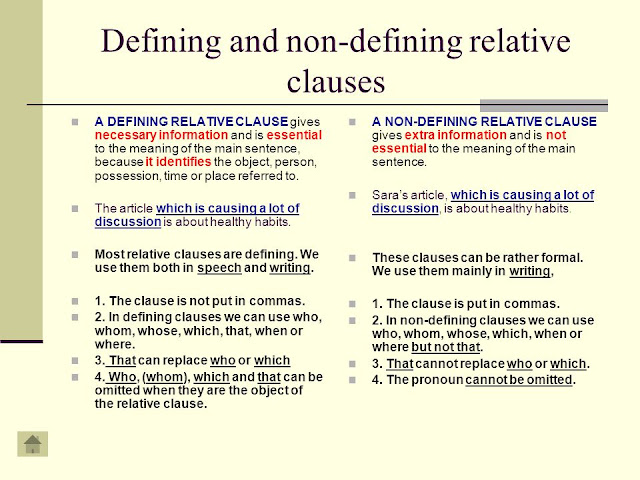Entradas
Mostrando entradas de febrero, 2022
2. LISTENING. GIVING DIRECTIONS
- Obtener enlace
- X
- Correo electrónico
- Otras aplicaciones
2. WRITING. DESCRIBING A PROCESS
- Obtener enlace
- X
- Correo electrónico
- Otras aplicaciones
HOW TO PLANT FLOWERS Put these actions into the correct order: you water the seeds every day. wait a few weeks for flowers to come out. dig a hole in the soil. a plant will grow out. plant the seeds. First , ................................................................................................ Then ................................................................................................ Next , ................................................................................................. After that , ....................................................................................... Finally , ........................................................................................... How to plant potatoes in a container in 5 easy steps Put these actions into the correct order: Place the seed potato chunks on t...
2. SPEAKING. DESCRIBING A PROCESS. HOW TO PRUNE A FRUIT TREE
- Obtener enlace
- X
- Correo electrónico
- Otras aplicaciones
2. READING. GRAFTING
- Obtener enlace
- X
- Correo electrónico
- Otras aplicaciones
Grafting Made Simple Grafting is a horticultural technique that is defined as attaching a twig (scion) from one tree to the stem of a tree seedling (rootstock). Tissues of different plants are joined together. The tissues fuse together and the two plants continue to grow as one. Farmers can’t combine just any two plants. The plants have to be similar enough that the rootstock won’t reject the scion that is being grafted to it. It is not too dissimilar to blood transfusions in humans. Grafting is done for a number of reasons. One reason is that some varieties of fruit have better roots and some have better fruits. Grafting allows farmers to combine the two and have the best rootstock and the best fruit. There are several types of grafting techniques that farmers can use. These include bark graft, side-veneer graft, splice graft, whip and tongue graft, saddle graft, bridge graft, inarch graft, etc. Scions are usually collected in the fall of the year after the plant ha...
2. PASSIVE VOICE IN THE PAST SIMPLE
- Obtener enlace
- X
- Correo electrónico
- Otras aplicaciones
2. LINKING WORDS: EXPRESSING CONTRAST
- Obtener enlace
- X
- Correo electrónico
- Otras aplicaciones

1.2. LIST OF IRREGULAR VERBS
- Obtener enlace
- X
- Correo electrónico
- Otras aplicaciones
2. RELATIVE CLAUSES
- Obtener enlace
- X
- Correo electrónico
- Otras aplicaciones

TELL THE DIFFERENCE BETWEEN DEFINING AND NON-DEFINING DEFINING: The student who/that recorded the video is studying Forestry. NON-DEFINING: John, who recorded the video, is studying Forestry. DEFINING: The teacher (who / that ) you met at the entrance teaches English. NON-DEFINING: Irene, who you met at the entrance, teaches English. DEFINING: The town where I live is in the north of Cáceres. NON-DEFINING: Plasencia, where I live, is in the north of Cáceres. DEFINING: The woman whose son works with me is very friendly. NON-DEFINING: Mrs Smith, whose son works with me, is very friendly. DEFINING: The month (when/that) I finish my exams is my favourite time of the year. NON-DEFINING: June, when I finish my exams, is my favourite time of the year. Decide whether the following clauses are defining or non-defining clauses. Insert commas where necessary. Omit the...
2. DEFINING RELATIVE CLAUSES
- Obtener enlace
- X
- Correo electrónico
- Otras aplicaciones
2. DEFINING RELATIVE CLAUSES PRACTICE
- Obtener enlace
- X
- Correo electrónico
- Otras aplicaciones
UNIT 2. ACTIVITIES
- Obtener enlace
- X
- Correo electrónico
- Otras aplicaciones

ACTIVITIES COMPREHENSION EXERCISES ANSWER THE FOLLOWING QUESTIONS: 1.-What does a seed grow when it germinates? 2.-What does a seed need to germinate? 3.-Why is water important in germination? 4.-What do we call the process by which plants produce their own food? 5.-Where do plants store sugar? 6.-Why are sugar and starches important for the plant? 7.-In which part or the plant are flowers formed? 8.-How would you define the flower? 9.-Why are the petals of a flower brightly colored and scented? 10.-How many parts does the pistil have? Can you name them? 11.-In which part of the flower is pollen made? 12.-What is the stigma like in order to attract pollen? 13.-How would you define the fruit? 14.-Can you name some pollinators? 15.-How are flower adapted to attract pollinator? 16.-Why are insects so important in pollination? 17.-Can you name different agents that help spread seed? COMPLETE THESE TEXTS WITH THE GIVEN WORDS pushes ...
UNIT 2. THE LIFE CYCLE OF A PLANT
- Obtener enlace
- X
- Correo electrónico
- Otras aplicaciones
Many plants grow out of seeds and bulbs. Seeds grow roots and shoots. Roots and shoots then grow leaves above ground. Many plants make flowers, which turn into fruits. Flowers and fruits make their own seeds. We call this a life cycle. Germination When a seed falls on the ground, it needs warmth and water in order to germinate; some seeds also need light. Dicots have seed coats that soften with moisture. After being planted in the soil for a few days, the seed absorbs water and swells until the seed coat splits. Monocots have harder seed coats that do not split, but stay in one piece. The stem, called the hypocotyl, pushes through the soil along with the cotyledons, or seed leaves; this is called germination, or sprouting. The tiny root pushes down and grows, looking for water and nutrients. Soon the cotyledons fall off and the first true leaves emerge. It is important that the seed is planted in the right place at the right time in order for it to germ...
